Sooner or later, all parents are faced with the problem of safely transporting their child in a car. And here questions arise regarding the selection, reliability and installation of a car seat. What is the Isofix system and how safe is this mounting option?
ISOFIX - a reliable and necessary system for attaching a child car seat
ISOFIX is a system for rigidly attaching a child car seat to a car seat. It was developed by ISO, an international standardization organization whose priority goal is to make the installation process of the chair as simple and reliable as possible.
The Isofix system is distinguished by its reliability and safety
It is worth distinguishing between two types of ISOFIX:
- power, which, in fact, is designed to completely stabilize and secure the chair in emergency situations. It is used in device categories 0+ and 1;
- non-power, used in car seats of senior categories.
If the device has the designations kidfix, seatfix or isifix, it means that it is a non-power ISOFIX, or more precisely, its analogue, which in emergency situations can only partially slow down the movement of the seat during a side impact, but nothing more.
When using ISOFIX analogues, the device for transporting a child is additionally secured with a standard seat belt, which takes on the entire load.
Error-free installation
Most often it is the installation child seat causes difficulties, despite the developed instructions. For example, a system that involves fastening with a seat belt has such disadvantages as missing it in the wrong groove, twisting, weak fixation, which can reduce all protection to zero.
Research shows that approximately 70% of car seats using a harness are not secured correctly.
With the ISOFIX system, standard belts are not required during installation. The chair is attached using two runners (brackets) with locks located at its base to steel brackets located inside the car seat.
Most cars are equipped with ISOFIX brackets, but it's best to make sure they are available before purchasing a child carrier. They are located on both sides of the rear car seat between the seat and backrest, but can be hidden by a zipper or a plug, which is indicated by a special symbol (an image of the silhouette of a child in a car seat). ISOFIX is not located in the front except in certain cases (for example, self-installation), because the rear seat is safer than the front.
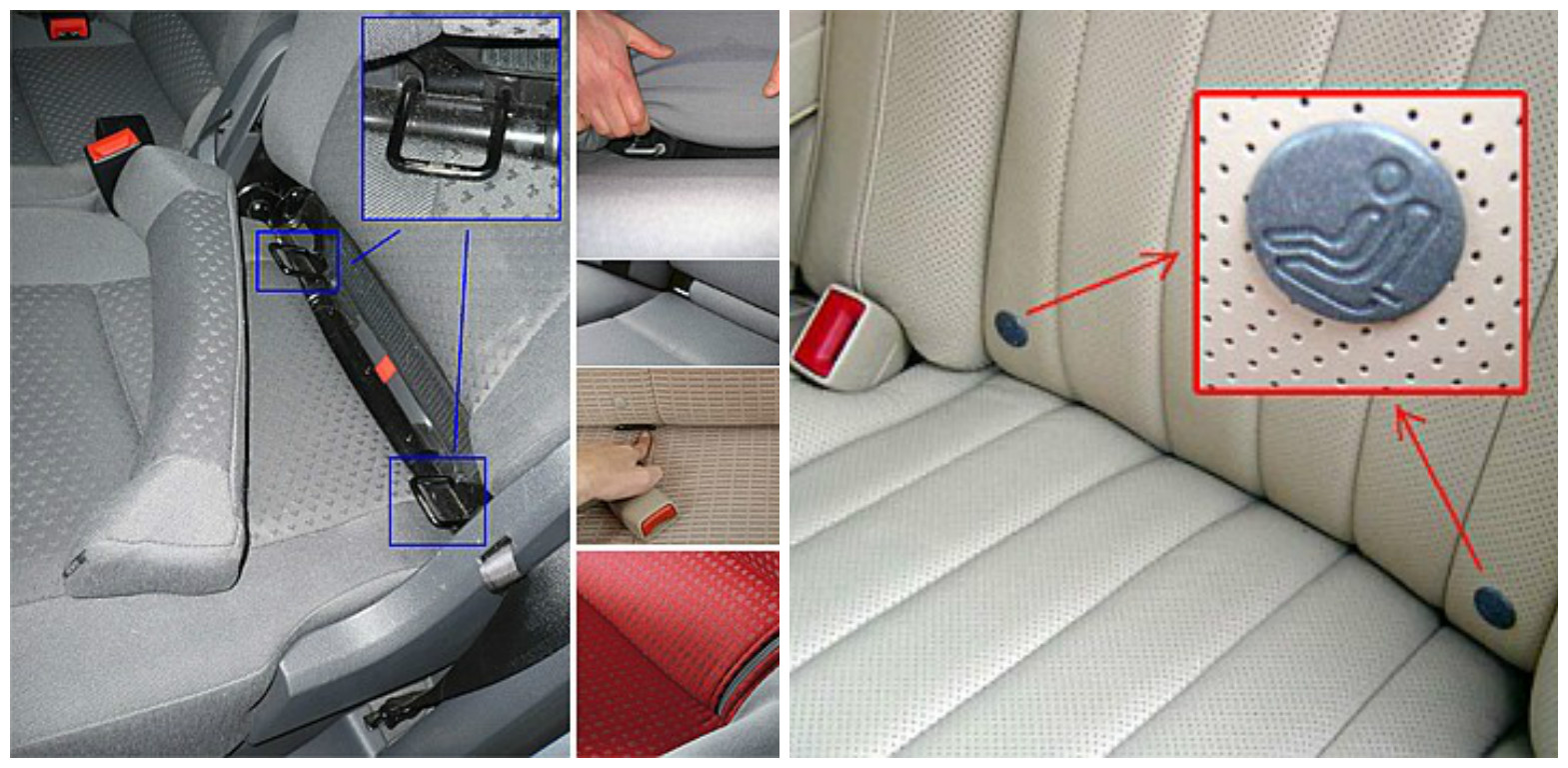
Staples can be hidden by zippers and plugs, indicated by a special symbol
ISOFIX for maximum safety and use of standard belt
The brackets to which the child car seat is attached are firmly welded to the car body. This allows the device to be stabilized as much as possible in the event of a collision, skid and other emergency situations. Some consumers are afraid that the rigidity of the system may harm the child. Various experiments refute this. For example, a crash test with Hybrid III dummies demonstrated that ISOFIX reduces pressure on the cervical region at the moment of impact.
It is no secret that the level of safety in a seat during a collision directly depends on the speed of action of the fastening systems. The faster it stabilizes, the more reliably the baby will be protected. The rigidity of external fastenings is leveled (reduced to nothing) with the help of the belts of the car seat itself, designed for this. ISOFIX can only be harmful if a category 2 or 3 device is attached to it, which will exceed the permissible weight and lead to an unreasonable increase in the load on the system.
Also, the load on the brackets and the entire system as a whole is reduced by using additional support points. There are two types:
- retractable leg, which is located at the base of the chair and, if necessary, is installed on the floor of the car;
- Top Tether anchor, which is a belt with a carabiner lock at the end, installed on the back surface of the car seat. It is attached to a hook welded in the trunk or behind the rear seat headrest. This anchor mount is universal and is available in most vehicles.
Types of additional support points - photo gallery
The extendable leg creates a third fulcrum in the ISOFIX system. The Top Tether anchor, like the leg, creates a third fulcrum in the ISOFIX system. 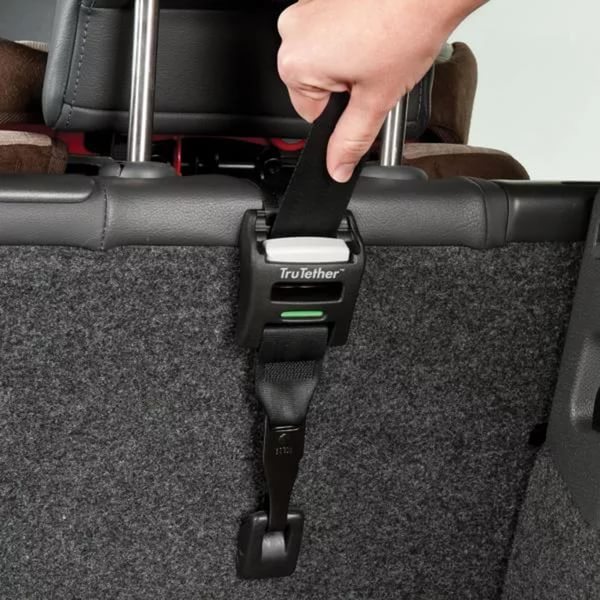 The Top Tether anchor attaches to a hook in the trunk or behind the rear seat headrest
The Top Tether anchor attaches to a hook in the trunk or behind the rear seat headrest
Disadvantages of the ISOFIX system
- In groups 2 and 3, ISOFIX is used simply for convenience, without having a protective function in emergency situations, since in this case they are performed by the car’s seat belt, and the system only provides additional fixation. It is used only in devices of age categories 0+ and 1, or on chairs where these are combined:
- in group 0+, the runners are built into a special base, on which the cradle is placed and automatically fixed against the movement of the car;
- in group 1, the runners are built into the lower part of the chair or also into the base.
- The weight of the child should not exceed 18 kilograms, and the ECE R 44/04 standard limits the weight of the chair itself to 15 kilograms. This is explained by the fact that during strong impacts, colossal loads are placed on the system, but its strength is still not unlimited.
- Equipping the ISOFIX system makes the chair heavier by 25–30% of its original weight. The cost of the product also increases by about 1.5 times.
- Since there are no uniform standards for the back seat of a car, when choosing a child car seat, you need to check whether it fits your car, whether the angle of inclination and height are the same.
Isofix with car seats of different weight categories - photo gallery
The car seat is installed on a special base into which the ISOFIX system is built. In car seats of categories 2 and 3, ISOFIX does not perform a protective function 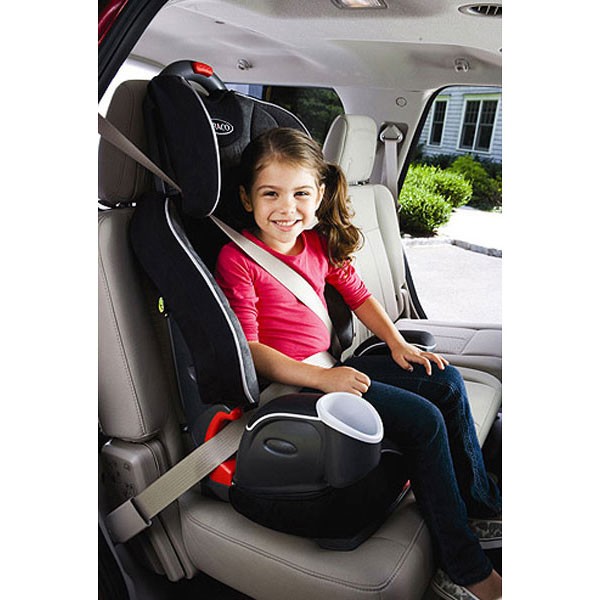 A child in a category 2.3 car seat is fastened with a standard seat belt
A child in a category 2.3 car seat is fastened with a standard seat belt
How to install and remove a car seat: instructions, photos and videos

How to secure a child car seat in a car - video
Where and how to attach isofix yourself
The ISOFIX system in the car can:
- installed by the manufacturer;
- be provided as an additional option;
- completely absent.
In the second case, for installation you need to purchase additional spare parts and secure them yourself or entrust this to an experienced car mechanic.
Post-factory installation - photo gallery
ISOFIX bracket for post-factory installation Holes for post-factory installation of brackets in the floor between the passenger compartment and trunk ISOFIX brackets installed
Is it possible to make isofix hinges with your own hands?
But even if you have an old-style car and there are no fastenings for ISOFIX in it, you can make them yourself. However, in this case, it is impossible to predict how the seat will behave in an accident; all responsibility for the child’s health lies entirely with the parents.
Homemade ISOFIX mount - photo gallery
A homemade bar for ISOFIX fastening is made by hand The bar is installed by attaching it to the car body The finished fastening is not noticeable and does not interfere with reclining the seat back
Opinions on whether it is necessary to install homemade Isofix in the car
Install a homemade isofix mount? It’s better to buy a regular chair that is secured with a standard belt.
https://www.u-mama.ru/forum/hobby/auto/635027/index.html
As I understand it, there is no difficulty in installing it - you apply it to the body, make marks at the fastening points, and drill. You put bolts on the inside and nuts on the outside. Nuts - with large washers and sealant, and bolts not made from OMA - and there will be happiness.
Yura 80
You can fasten it with both a belt and IsoFix at the same time, I was personally convinced of this (category 1). But the fact is that when the child grows up, he will have to be secured with a belt himself, and the chair under him will fidget. Personally, my opinion is that it is better to let the chair be secured with a “homemade” IsoFix than to simply dangle under the child, and in addition to this, the child will also be secured with a belt.
Hinstein
http://www.audi-belarus.by/forum/viewtopic.php?t=57318
Many car enthusiasts, when faced with the term ISOFIX, do not know what it is and why it is needed. In this article we will try to close this knowledge gap. Here you will learn what ISOFIX is in a car, why it is needed, and what its advantages and disadvantages are. If you are planning to buy a car, then this information will allow you to make right choice, ensure safety and avoid traffic violations.
Why do you need an ISOFIX system in a car?
According to the requirements of traffic regulations, transportation of children in passenger vehicles is permitted only with the use of special seats. At the same time, the seats must ensure the safety of the minor passenger in any emergency situations.
What do ISOFIX mounts look like?
Many manufacturers produce such devices, but the variety of models and mounting methods has increased negative factor. The fact is that the use of various modifications of car seats led to frequent errors during their installation. As a result, children suffered even in minor accidents.
This is what caused the emergence of a single international standard for rigid fastenings child car seats directly to the machine body. This standard was introduced by the ISO International Institute and is called ISOFIX or ISO FIX.
In addition to ISOFIX, there are alternative standards for securing car seats. For example, in the USA the standard is quite popular LATCH, and in Canada - UAS.
How to install an ISOFIX seat
Thanks to the simple design of the fastening elements, it is possible to minimize the number of errors when installing car seats for children. At its core, Isofix consists of two brackets that are attached directly to the car body. The standard place for their installation is the space between the back and seat of the rear passenger seats.
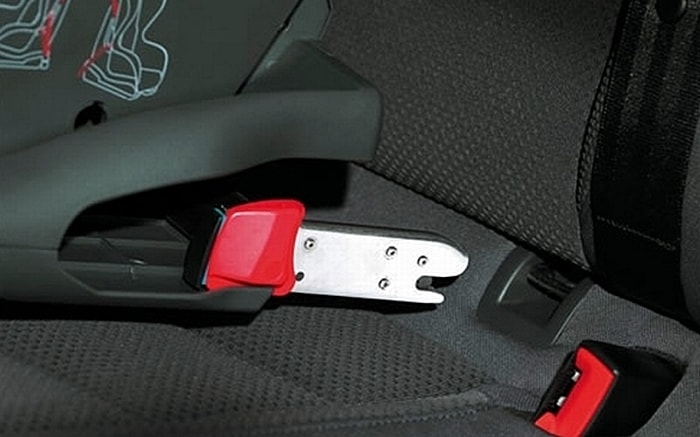
Installing an ISOFIX seat
To install the car seat, you just need to guide it along the slides and brackets and snap the included latches into place. It is almost impossible to make a mistake during such operations, and the reliability of fixation is quite high.
There are also modifications of child car seats with additional attachment points. Manufacturers claim that such models provide a higher degree of child protection.
- Modifications with retractable (telescopic) thrust leg. This support makes it possible to prevent the chair from moving forward during frontal impacts, although it creates some inconvenience during operation.
- Models with anchorage, which have an additional fixation point using a special belt with a carabiner. The seat belt clip may be located behind the seat headrest or on the floor of the luggage compartment. This modification is considered more convenient and no less reliable. Almost all new cars are equipped with this version of the ISOFIX system.
It should be noted that most child car seats with the ISOFIX fastening system can also be secured using regular car belts. This can be useful if the seat needs to be used in a car that is not equipped with the appropriate mount.
What types of car seats are there with Isofix mounting?
The Isofix mount is used to secure car seats designed for a child weighing up to 18 kg. These are the so-called group 0+ and group 1.

Car seats with ISOFIX mounting groups 0+ (left) and 1 (right)
Group 0+ car seats are used for newborns and children weighing up to 13 kg. This design is a set of two main elements - the carrying chair itself (cradle) and the base, which has an Isofix type fastening. The main advantage of such modifications is the ability to comfortably carry even a sleeping child. You just put the chair on the base, press it, and the safety of the trip is ensured. The disadvantages of such a system traditionally include increased cost; both the base and the carrier itself are quite expensive.
Group 1 car seats are used for people weighing 9-18 kg. At its core, it is a traditional chair with a standard mount built into the bottom of the chair. Special design differences is not available, and its simplicity allows for reliable fixation and safety.
Combined ones have also appeared on sale. car seats group 0+/1, which can be used for any child weighing up to 18 kg. Such modifications can be installed both in the direction of travel and against it. In this case, the Isofix fastening is used mainly exclusively for group 0+. Some models have a system for rotating the car seat bowl (up to 180 degrees), making it easier to place or disembark the child.
Video about ISOFIX in the car
Some disadvantages of ISOFIX mounting
The main drawback, as already noted, is the weight limit. If the child's weight is more than 18 kg, it is technically impossible to ensure reliable fastening of the chair under emergency shock loads due to a certain strength limit of the structural elements.
Some difficulties are also caused by differences in the design of the passenger seats themselves. Different shape backrests, headrests, differences in size and other factors complicate the use of standard Isofix fasteners.
Isofix is a system for securing child car seats. appropriate international standard. Introduced by the ISO International Institute in 1990 (standard number: ISO 13216). Hence the name: ISO stands for International Standards Organization ( International organization according to standardization), and fix is translated as “fastening”, “fixing”.
Isofix allows you to quickly and, most importantly, reliably install a child restraint system in your car. The mount consists of two autonomous parts. The first is metal brackets in the body structure (under the back of the rear seats), the second is metal retractable brackets at the bottom of the child seat. To install the chair, you need to connect these two parts together, that is, insert the latches on the brackets into the brackets.
Where to look for Isofix in your car?
If you are planning to purchase an Isofix restraint system for your baby, check whether your car has brackets for securing it. You need to look for them in the gap between the backrest and the seat of the rear seats. In some cars you can easily find the staples by just slightly pulling apart the upholstery, in others you will have to stick your hand deeper, as they may be “recessed” inside.
What to do if you don't find Isofix mounts in your car?
Secondly, Isofix may be absent in principle, which happens even in modern models. In this case, you can consider child car seats with a standard type of fastening.
Third, if Isofix is not provided in the car, but you basically want to use it, you can contact a car service. Specialists will install the brackets into the car body.
Car seat group “1”(9-18 kg) can also be placed on any passenger seat.
The design of the product allows it to be installed in both directions of travel, but most parents prefer to transport their children facing forward.
Group 2 car seat(15-25 kg) is located exclusively in the direction of travel on any passenger seat. The internal belts of the car seat are replaced by a regular car seat belt, which secures the child.
Advantages of Isofix
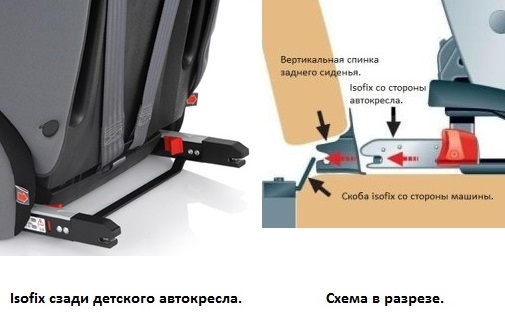
Easily and quickly attaches to the car interior. Installing the car seat takes just a few seconds. You don't have to constantly fiddle with the belt, passing it through all the slots.
The likelihood of incorrect installation is minimized. More than 70% of child seats with a standard type of fastening are installed with gross errors! It is almost impossible to fix a chair with Isofix incorrectly. All you need to do is guide the brackets onto the metal brackets and snap the locks into place.
Reliable child protection in case of an accident. Today, a car seat with Isofix is considered the safest option for transporting a child, which is confirmed by independent crash tests.
The seat is installed rigidly, it does not “move” forward and does not move around the cabin. Regular seat belts can become loose while driving, especially if the child seat is fastened hastily. Using Isofix, you can be sure that the car seat will not move out of place. It will not “jump” around the cabin if you often drive without your baby, but do not remove his seat from the car.
Instructions for installing a car seat with built-in Isofix
Step 1. Locate the metal brackets at the junction between the backrest and the seat. Remove the plugs from them (if any). Some car seat models include bracket guides that attach to the brackets and make installation easier.
Step 2. Pull out the car seat brackets. They may also have plugs that need to be removed! and snap them onto the brackets. Place the plugs immediately in the glove compartment so they don’t get lost in the car.
Step 3. Adjust the anchor strap Place it over the back of the rear seat and fasten it to the loop located either on the trunk floor or on the back of the seat.
Step 4. Place your child in the seat. Tighten and secure the internal five-point harness.
Instructions for installing a car seat with a base
Step 1. Locate the metal brackets at the junction between the backrest and the seat. Remove the plugs from them (if any).
Step 2. Place the base on the seat. To extend the mounts, use the button on the front of the base. Align the base mounts with the Isofix mounts in your vehicle. If the system has worked, green indicators will appear.
Step. 3. Move the base as close as possible to the back of the seat.
Step 4. Adjust the additional stop to the floor. Press the button on the stop leg and select the desired length. If you did everything correctly, the green indicators will light up.
Step 5. Place the car seat on the base, aligning the fasteners until it clicks. Green indicators will allow you to make sure that the chair is truly securely fastened. Remember that the car seat is placed exclusively against the direction of travel of the car.
Step 6. Place your child in a seat and secure the internal five-point harness.
To remove the car seat, use a special lever (most often it is located behind the back of the seat).
Groups "0", "0+", "1"
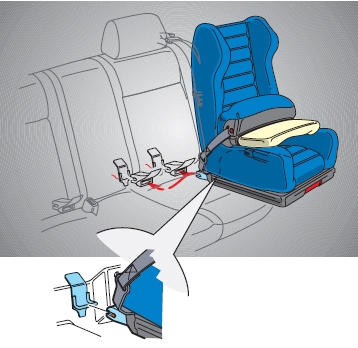
As the main method of fastening, Isofix can be used to transport children weighing up to 18 kg (up to approximately 4 years), which corresponds to groups “0”, “0+”, “1”. This rule is strictly regulated by the ECE R44/04 safety standard. The fact is that in the event of an accident, the Isofix mount bears a huge load, or rather, it takes on the entire force of the impact, so the weight of the child is a fundamental factor.
Group “0+” (up to 13 kg) are infant carriers that are installed rear-facing. They do not have built-in Isofix, so special bases are used. And this is quite convenient, since you can take the cradle with your baby out of the car at any time, just by pressing a button or pulling the handle. But there is also a fly in the ointment here. A car seat with Isofix is an expensive pleasure. The chair itself costs an order of magnitude more than standard models, plus you will have to pay about the same for the base. When a child grows out of the 0+ group, in most cases you will not be able to use the base with another chair (even from the same manufacturer). The exception is rare models.
In group “1” car seats (9-18 kg), Isofix brackets can be built into the base of the product itself, but bases are also used.
In models of the combined type of group 0+/1, the Isofix system is often built into the base of the car seat. Please note that child seats in this group can be installed both in the direction of travel and against the direction of travel. Therefore, some manufacturers make the bowl rotating so that, if necessary, you can change the direction of installation.
Groups "2", "3"

As noted above, the Isofix system has a weight limit of 18 kg. Car seats of groups “2”, “3” are intended for children from 3 years old weighing 15-36 kg. Isofix in these models can only be an additional method of fastening (not the main one!). And it cannot be said that in groups “2” and “3” Isofix is used in its pure form. We are talking about its modifications, which is why such fastening systems are called differently: Kidfix, Isofit, Smartfix, etc. They allow you to provide additional safety for the child, as well as secure the child seat so that it does not “ride” around the cabin. In the seat, the small passenger is also fastened with a standard seat belt using special guide marks. It is the three-point belt that bears the entire load in the event of an accident. It is important that the restraint system has relative mobility, allowing it to move with the child until the three-point belt operates. Thanks to this, the baby is provided with side protection and the seat belt is routed correctly. That is, the “correct” Isofix with a rigid fastening of the car seat in combination with a standard belt is inappropriate, as well as an anchor belt or a persistent “leg”.
Conclusion: for groups “2”, “3” systems are used that are similar in principle to Isofix installation, but modified to meet the safety requirements for models of these age groups and are compatible with the standard seat belt. Namely: they shift, unfasten or move forward when loaded.
"Anchor" belt and telescopic stop
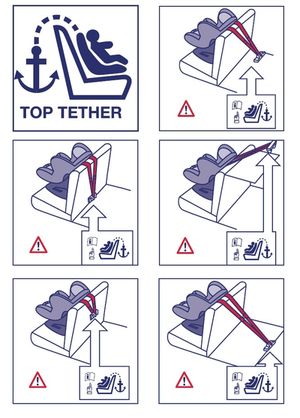
Isofix fixes the chair at 2 points on the same axis. In the event of an accident, this axle is subject to enormous loads, like all fastenings of the system. There is a danger that the upper part of the chair may suddenly move forward, and the fastenings may not hold up. Therefore, it is recommended to use a third support point to reduce the load on the restraint mountings. The third point of support could be:
Telescopic retractable stop at the floor. It consists of two connected tubes located at the base of the holding device platform, which are height-adjustable and rest against the floor. The persistent “leg” prevents the chair from rotating and also reduces the load on the brackets.
Top Tether anchor strap. It is located at the top of the car seat at the back, and has a carabiner-type fastening at the end. The carabiner must be secured to a special bracket. It can be located either in the trunk or on the back side of the rear seat of the car. Top Tether secures the top of the car seat, protecting the little passenger from a sudden “bounce” during a collision, which can lead to neck injuries.
Note! There are several models where it is possible to use Isofix without a 3rd point of support. The design of the guides in them is movable, which makes it possible to evenly distribute the load.
These car seats are not universal. A list of car models compatible with them is usually attached to the instructions or can be checked with a specialist.
A third support point is also not required in cases where a fixing table is provided instead of an internal five-point belt.
What is the safest place in the car?
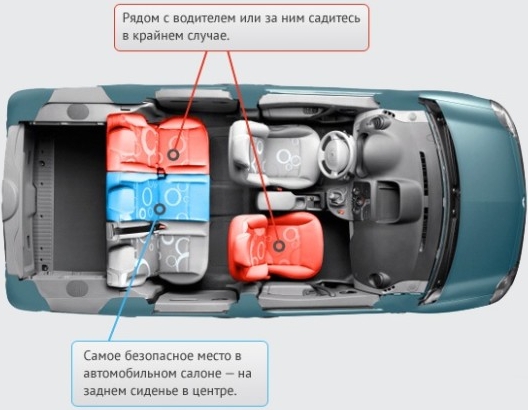
There is no consensus on this matter. For a long time, the seat on the left (behind the driver) was the “favorite” among safety experts. This choice is explained by the human instinct of self-preservation: in an emergency situation, the driver unconsciously turns the steering wheel in such a way as to protect himself, which means that the passenger behind also benefits.
However, scientists at the American Research University at Buffalo called the most safe place There is a middle seat in a car. According to researchers who analyzed traffic accident statistics in New York State for 3 years, compared to the front seat, the rear seats are 60-86% safer, while the safety of the middle seat is 25% higher than that of the outboard rear seats. The researchers explained this by the fact that during a collision it is not subject to compression, which cannot be said about the “sidewalls”.
The foreign publication Pediatrics also conducted its own investigation on this issue. Published results indicate that over 50% of childhood injuries and deaths in road traffic accidents could be avoided if the car seat was installed in the rear seat of the car instead of the front seat.
As you can see, the car seat is front seat– this is far from the safest way to transport a child. We objectively talked about all its advantages and disadvantages. The choice is up to the parents!
Caring parents!
Together we make the world safe and comfortable.
Child safety expert




